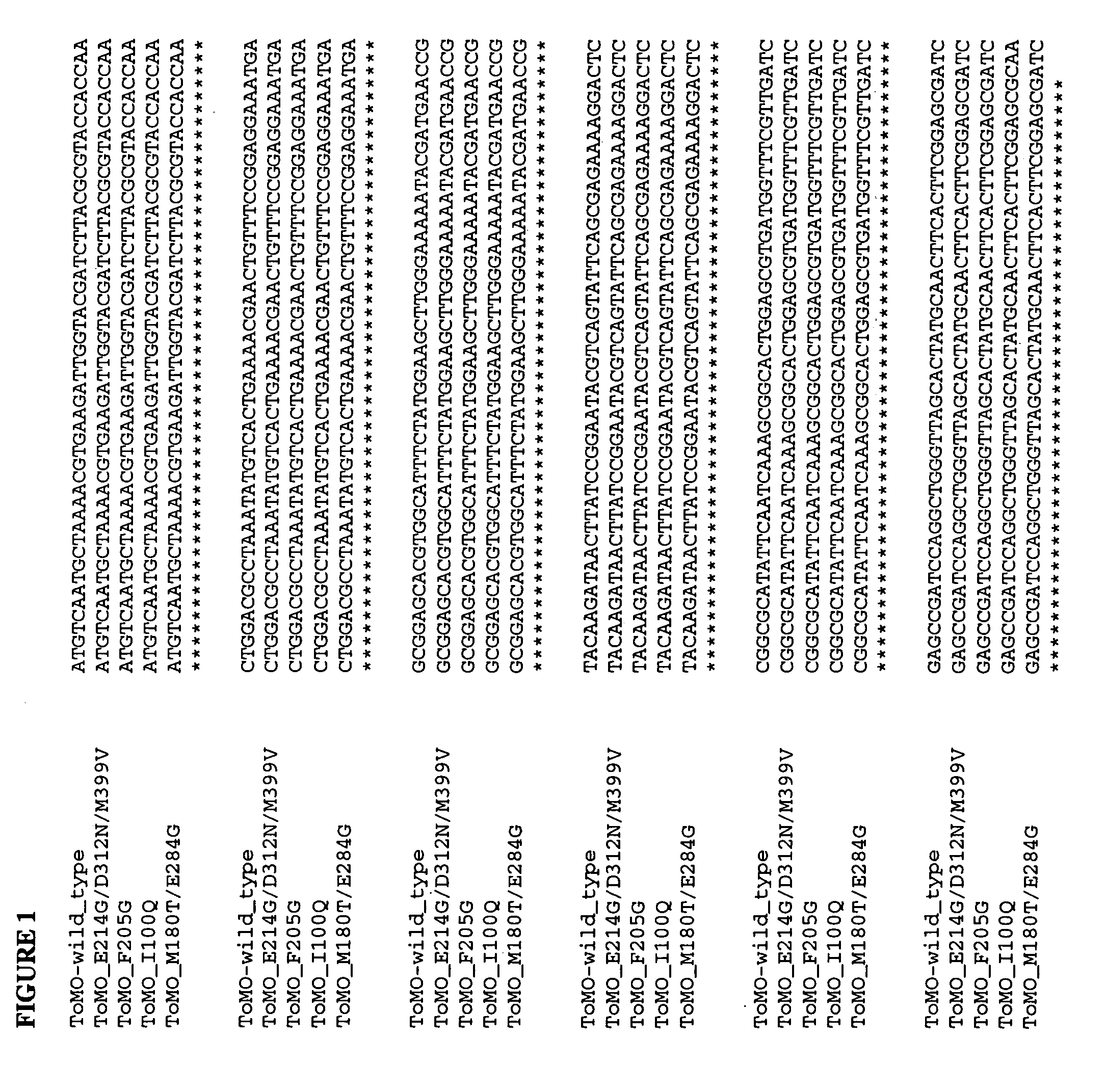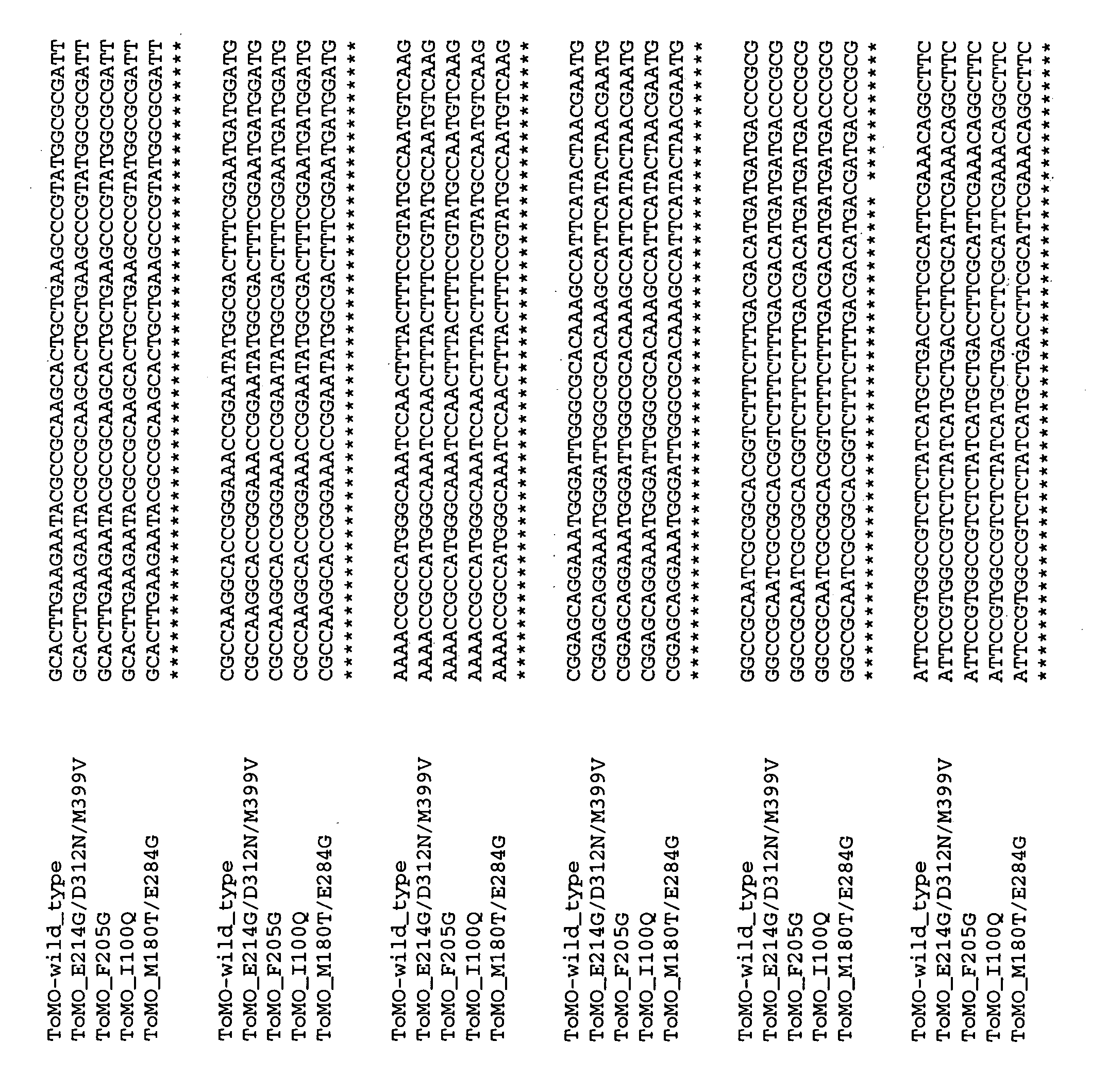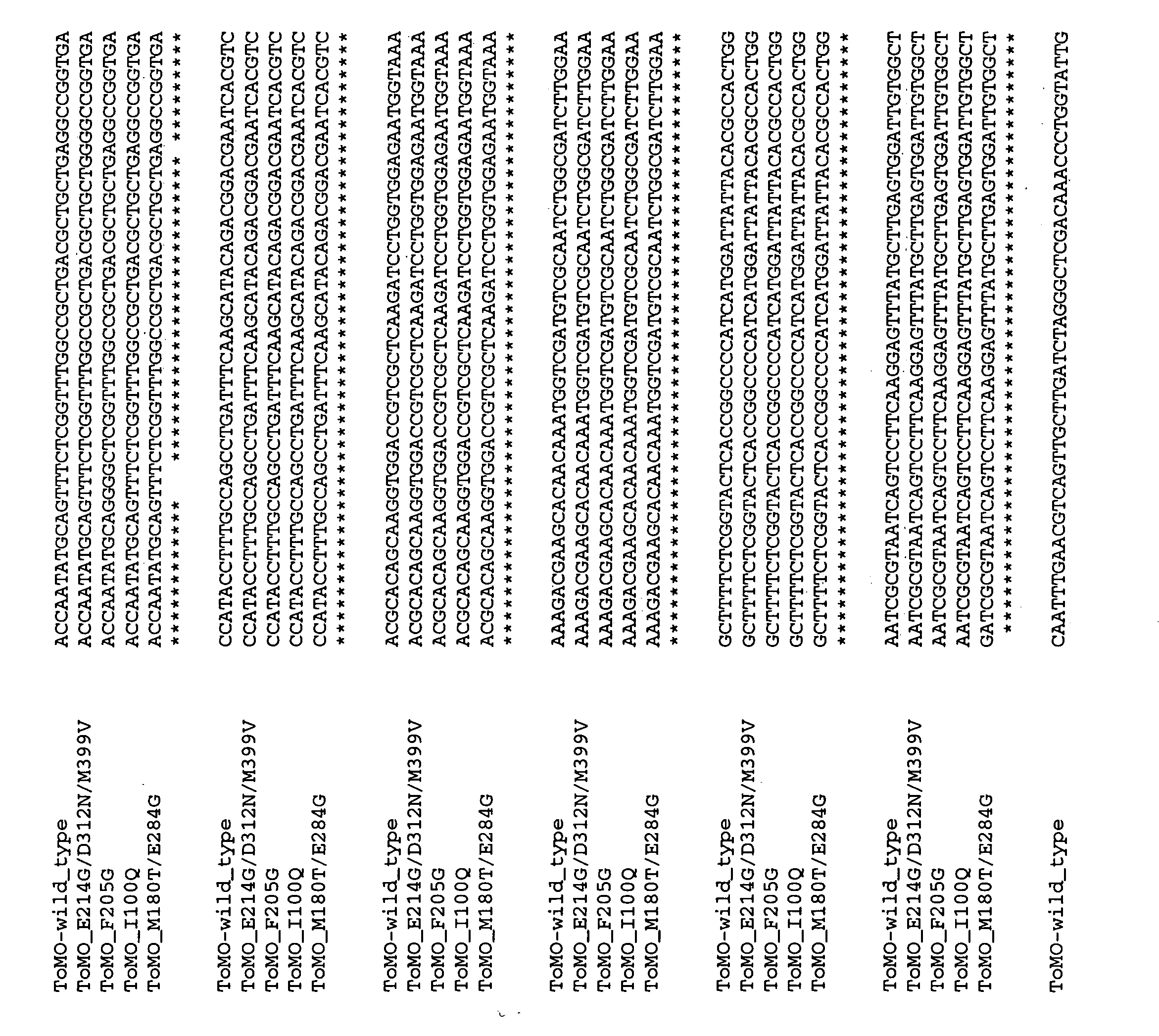Directed evolution of recombinant monooxygenase nucleic acids and related polypeptides and methods of use
a monooxygenase and polypeptide technology, applied in the direction of directed macromolecular evolution, nucleotide libraries, peptides, etc., can solve the problems of complex structure, high cost of starting materials, and inability to easily synthesize compounds by chemical routes, so as to increase the chemoselectivity of a polypeptide encoded, increase the range of monooxygenase substrates, and increase the ability to chemically modify substrates
- Summary
- Abstract
- Description
- Claims
- Application Information
AI Technical Summary
Benefits of technology
Problems solved by technology
Method used
Image
Examples
example # 1
EXAMPLE #1
Directed Evolution of Toluene-4-Monooxygenase of Pseudomonas mendocina KR1 for the production of 4-Nitrocatechol from Nitrobenzene.
Detailed Methods.
[0172] Chemicals. NB was purchased from Fisher Scientific Co. (Fairlawn, N.J.) and 4-NC, p-cresol, and o-, m-, and p-nitrophenol were obtained from Acros Organics (Morris Plains, N.J.). o-Cresol and m-cresol were obtained from Aldrich Chemical Co. (Milwaukee, Wis.). All materials used were of the highest purity available and were used without further purification. Bacterial strains and growth conditions. Escherichia coli strain TG1 (supE hsd.5 thi .(lac-proAB) F.[traD36 proAB+lacI q lacZ.M15]) (Sambrook et al. 1989) was utilized as the host for gene cloning and 15 expression. TG1 was routinely cultivated at 37° C. in Luria-Bertani (LB) medium (Sambrook et al. 1989) with kanamycin (100 μg / mL) added to maintain the vector pBS(Kan)T4MO (Tao et al. 2004) which expresses the tmoABCDEF genes from a constitutive lac promoter and w...
example # 2
EXAMPLE #2
Directed Evolution of Toluene 4-Monooxygenase by Active Site Engineering for the Synthesis of 3-Methoxycatechol, Methoxyhydroquinone, and Methylhydroquinone
Detailed Methods
[0184] Chemicals. o-Methoxyphenol (guaiacol, 98%), 3-methoxycatechol, and p-cresol (99+%) were obtained from Acros Organics (Morris Plains, N.J.). o-Cresol (99+%), m-cresol (97%), methoxyhydroquinone, 4-methoxyresorcinol, 3-methylcatechol, 4-methylcatechol, methylhydroquinone, and 2-methoxyresorcinol were obtained from Sigma-Aldrich Co. (Milwaukee, Wis.). All materials used were of the highest purity available and were used without further purification.
[0185] Bacterial strains, plasmids, and growth conditions. Plasmid pBS(Kan)T4MO (FIG. 17) which constitutively expresses T4MO tmoABCDEF was constructed as described previously. In pBS(Kan)T4MO, the lac promoter yields constitutive expression of T4MO due to the high copy number of the plasmid and lack of the lacI repressor. Kanamycin resistance was add...
example # 3
EXAMPLE #3
Protein Engineering of Toluene-o-Xylene Monooxygenase from Pseudomonas stutzeri OX1 for Synthesizing 4-Methylresorcinol, Methylhydroquinone, and Pyrogallol
Detailed Methods
[0199] Bacterial strains, growth conditions, and SDS-PAGE. Escherichia coli strain TG1 was used as the host with pBS(Kan)ToMO and its variants. Cells were initially streaked from −80° C. glycerol stocks on Luria-Bertani (LB) agar plates containing 100 μg / mL kanamycin and incubated at 37° C. After growth on LB agar plates, cells were cultured from a fresh single colony in LB medium supplemented with 100 μg / mL kanamycin at 37° C. with shaking at 250 rpm (New Brunswick Scientific Co., Edison, N.J.). The relative expression of the touA loci from E. coli TG1 / pBS(Kan)ToMO was evaluated using sodium dodecyl sulfate-polyacrylamide gel electrophoresis (SDS-PAGE) with a 12% Tris-HCl gel both with and without 1 mM isopropyl-β-D-thiogalactopyranoside (IPTG, Fisher Scientific. Co., Fairlawn, N.J.).
[0200] Chemical...
PUM
| Property | Measurement | Unit |
|---|---|---|
| temperature | aaaaa | aaaaa |
| pH | aaaaa | aaaaa |
| OD | aaaaa | aaaaa |
Abstract
Description
Claims
Application Information
 Login to View More
Login to View More - R&D
- Intellectual Property
- Life Sciences
- Materials
- Tech Scout
- Unparalleled Data Quality
- Higher Quality Content
- 60% Fewer Hallucinations
Browse by: Latest US Patents, China's latest patents, Technical Efficacy Thesaurus, Application Domain, Technology Topic, Popular Technical Reports.
© 2025 PatSnap. All rights reserved.Legal|Privacy policy|Modern Slavery Act Transparency Statement|Sitemap|About US| Contact US: help@patsnap.com



